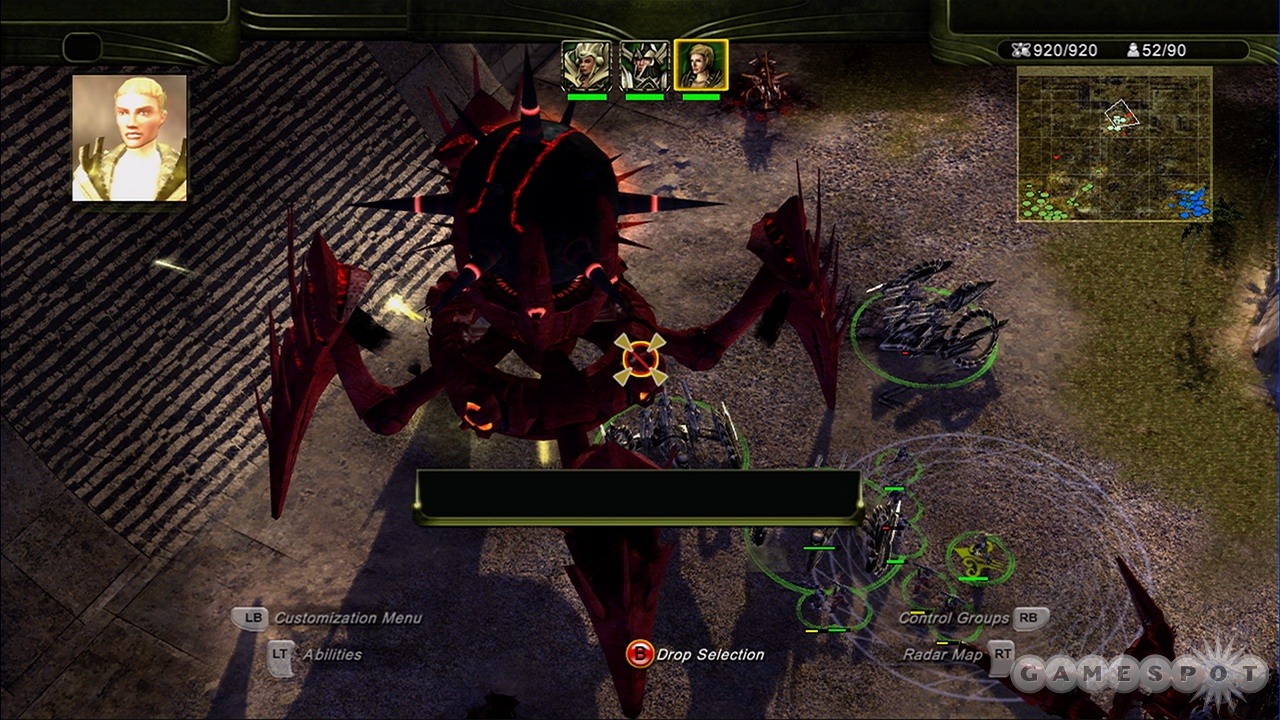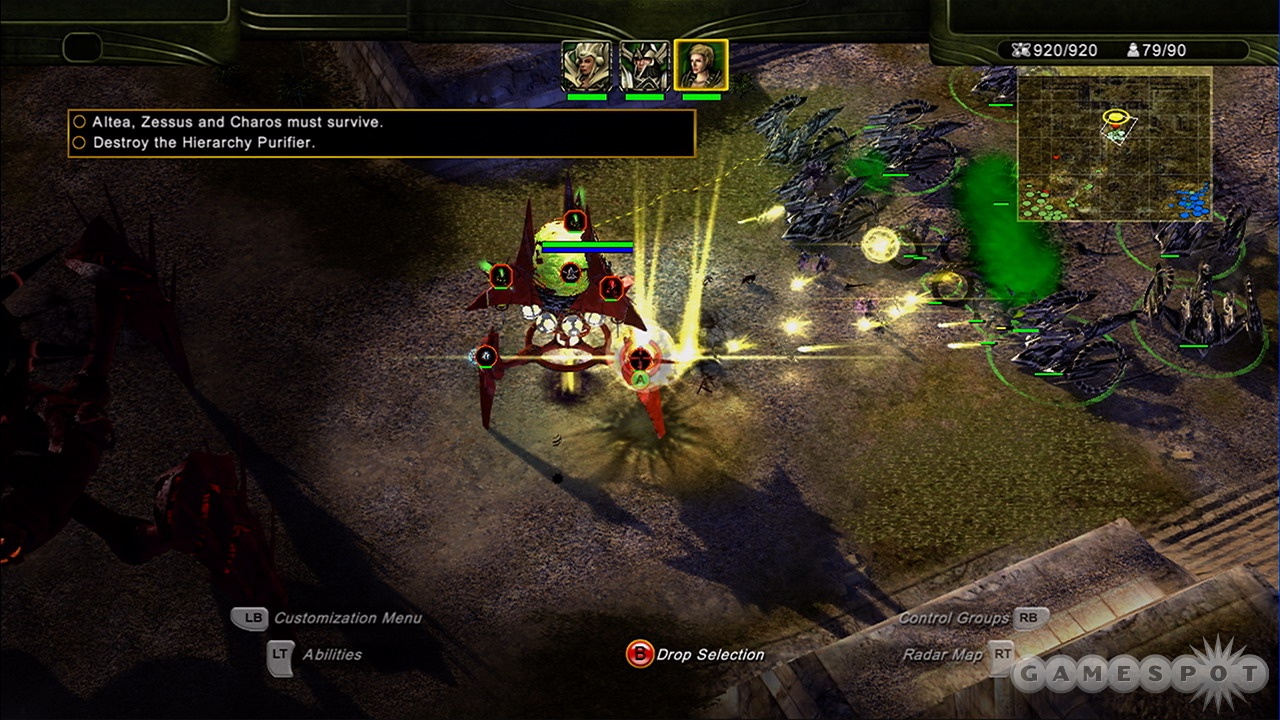Universe at War absolutely bursts with interesting units and neat twists on genre standbys. It's hard to not appreciate a real-time strategy game that lets you outfit hulking robotic walkers the way you want and send them into battle. Yet despite its awesome mechanical arachnids, the game gets in its own way by failing to fix some obvious problems present in the PC version, as well as adding a major one of its own: namely, a frame rate that dips frequently into the single digits. In a genre that relies on quick thinking and smooth command of the battlefield, it's an inexcusable issue. Throw in some smaller bugs, and you have an entertaining game that squandered its own enormous potential with terrible quality assurance.
The aforementioned behemoths of might and metal belong to the Hierarchy faction. The evil-and-proud-of-it Hierarchy brutes have attacked the Earth to gather its resources. The robotic Novus arrive with the intent of obliterating the galactic bullies once and for all, but they casually dismiss the possibility of saving the planet (doing so wouldn't be consistent with their programming). The Masari, self-proclaimed gods with a flair for arrogance, arrive fashionably late to the party. Apparently, they created the Hierarchy eons ago and are now upset that they let things get so out of hand. Although there are some interesting characters--such as Mirabel, the lone human among the aloof Novus--the story is told with the sophistication of a sledgehammer to the forehead. Cutscenes look relatively crude, the corny dialogue is laughable, and the amateur voice acting reduces every character and unit quip to a prehistoric science-fiction cliche.
The big twist here is that even though some alien commanders admire humankind's spunk, the Earth's natives take a backseat during the strife that unfolds. And that's just as well, given that all three alien factions are incredibly unique, each offering its own variant on RTS formulas. Those gigantic walkers are such variants. Playing as the Hierarchy, you can create three different types of walkers and outfit their hard points (installation locations) with infantry-creation pods, plasma turrets, magnets that paralyze vehicles, and other cool goodies. If you find yourself facing one, you need to target the unit's hard points before you attempt to take out its core, or you'll get nowhere. For the Novus, speed is the name of the game. Using power conduits, you can spread quickly across the map, and units can use these conduits to speedily zoom around and harass opponents. Building bases as the Masari is a little more straightforward, but they have two modes of play: light and dark. In light mode, you have access to airborne units, and movement speed is increased. In dark mode, your attacks change (even that of your superweapon), and flying units are grounded. The differences seem subtle at first, but knowing those distinctions can have a noticeable effect on the battlefield. Overall, it's a wonder that these three wildly different factions are balanced so well.
The Novus and Hierarchy campaigns embrace the tired method of limiting missions to a limited selection of units and sending you on a linear path to victory. It's a good way of getting you used to the unfamiliar, but both of those campaigns abruptly end before you can explore all of the available research options and units. A few missions, such as one in which you take control of a single hero unit and a few infantry, are the worst types of RTS puzzles, and hardly play to the game's strengths. Once the Masari campaign kicks in, things take an exciting turn for the better. The global map, previously just a visual device employed in cutscenes, is now at your command. Here, you can move from one territory to the next, create strike forces outside of the skirmish itself, and build structures in captured territories. It's a great introduction to another mode, called Conquer the World, but you can easily exploit it because the global events in the campaign are scripted. For instance, since you don't need to worry about any territories getting attacked, you can take as much time as you need to build units before you ever head to battle. It's fortunate that the battles themselves are fun, if a bit straightforward, and that the final showdown is intense and challenging.
Outside of the campaign, you can take on the AI in individual skirmishes, though you'll get the most mileage out of the Conquer the World mode and in online matches. In Conquer the World, you battle opponents on a global scale, moving heroes and their strike forces from territory to territory, building structures and unleashing superweapons and spies. It's all in real time, and it's compelling enough to keep you engrossed for hours at a time. You can also take this method of play online, where you face an opponent in a particular territory. If you win the skirmish, you seize the territory in your own game. It's a great idea and works like it did on the PC, though a week after release, we couldn't find a single person competing in this mode. However, we did find players competing in ranked and unranked matches, and several of the games were terrific and intense. It's here that the game should, in theory, shine.
Instead, the game suffers because its technical gaffes become more obvious. No matter whether you're playing on your own or against another player online (but especially if you are playing online), the frame rate chugs as soon as there is any excitement on the screen--sometimes drastically so. This isn't a small annoyance; at times, the action becomes a slide show in which the game doesn't respond to commands, the map choppily scrolls, and your units move as if they were wading through treacle. These gigantic drops in frame rate probably won't ruin the game for you, but they may come close to doing so. It isn't as if Universe at War looks like it's pushing the hardware. Its better unit and structure designs are impressive, and battles do produce a lot of bright, colorful particle effects and explosions. Regardless, Universe at War isn't a technical powerhouse; it's replete with low-resolution textures and bland environments, which makes it hard to forgive these problems.

Developer Petroglyph did succeed at bringing a comfortable control scheme to the Xbox 360 version of Universe at War. The most notable advance here is with the minimap, which you can enlarge with the right trigger and then use to quickly scroll around the map. It's also a snap to create control groups, access production queues from anywhere on the battlefield, and cycle through available special attacks. The overall scheme isn't as good as those found in other Xbox 360 strategy games, but it functions well enough. It could have used some further refinement; for example, it can be tough to select a small unit with your reticle, or to select a certain hard point on a walker. These quirks wouldn't be such a chore if the game's friendly artificial intelligence was more helpful. As it is, you need to heavily micromanage most encounters, and small foibles like these stand out as a result. With a patch on the horizon that will let PC players compete with Xbox 360 players online, it should be interesting to see how the control differences manifest themselves in a competitive environment.
There are other annoyances to be found, some of which are small and others more noticeable. For example, you are given the option to turn off pop-up tips by pressing the Y button, but it doesn't actually work. And as in the PC release, the camera remains maddeningly close to the battlefield, even when it's pulled all the way back. All of these problems hinder what should have been a great new addition to an ever-growing selection of real-time strategy games on the Xbox 360. The incredible variety within may win you over in spite of these drawbacks, but there's no reason you should be forced to overlook the frustrations just to get to the good bits.
